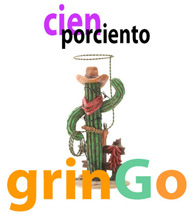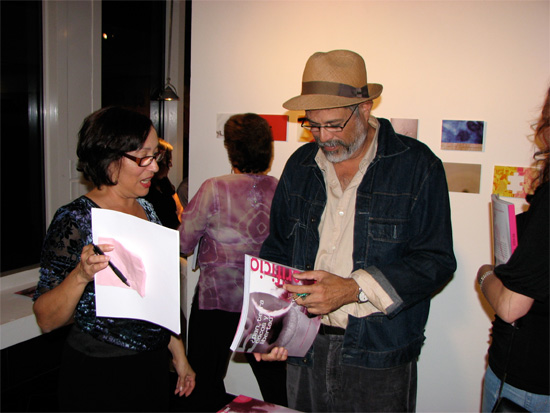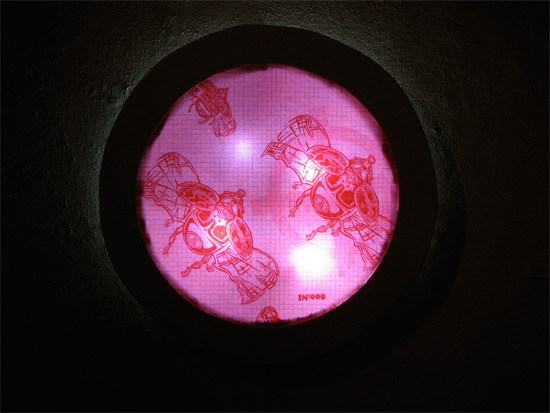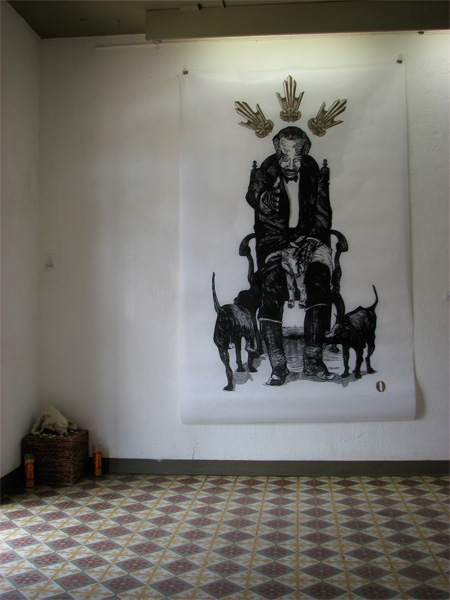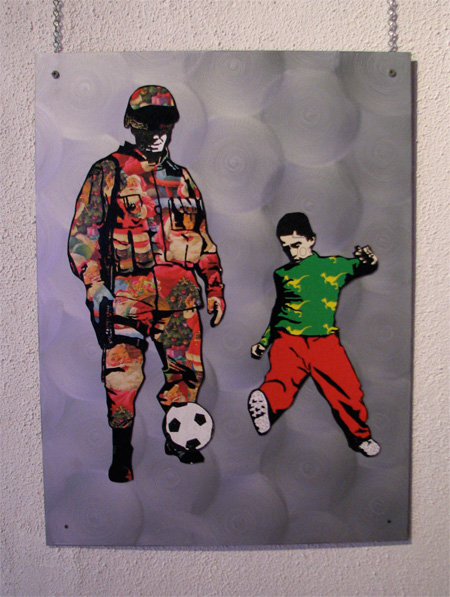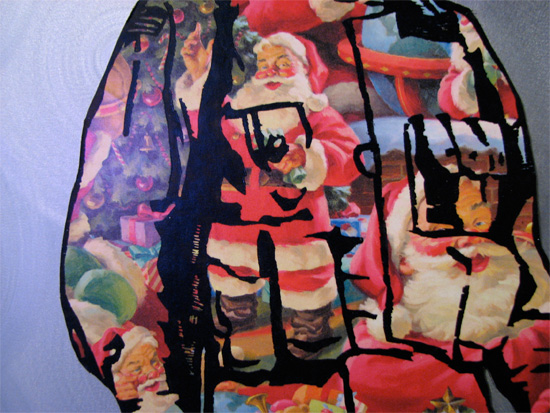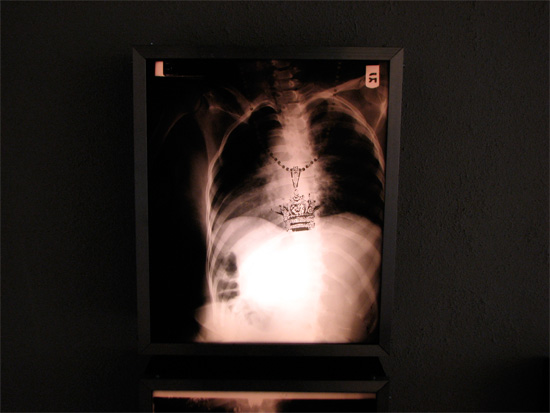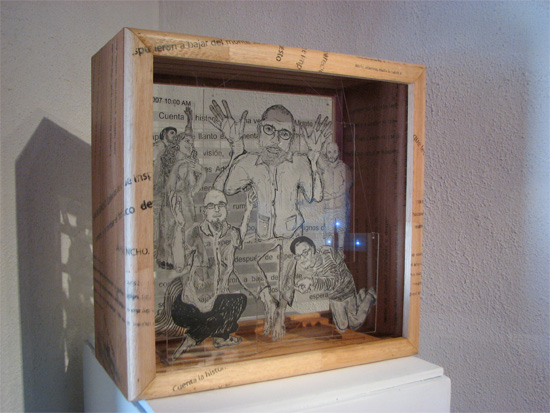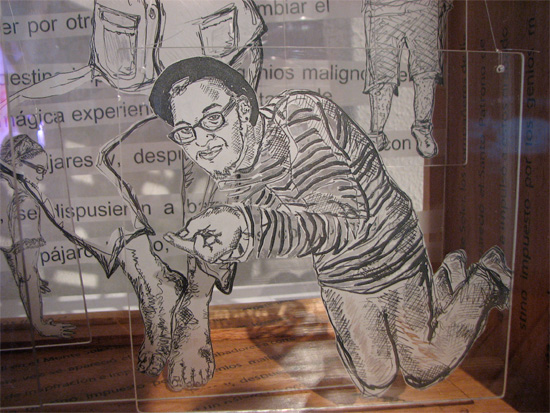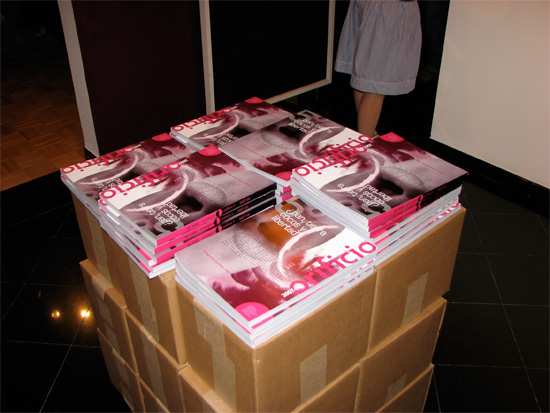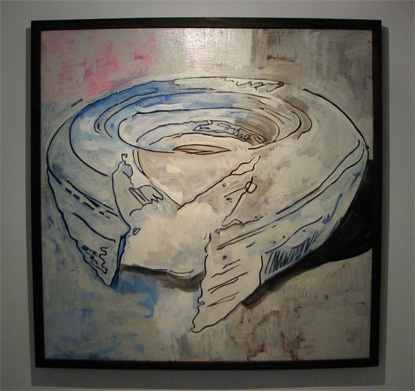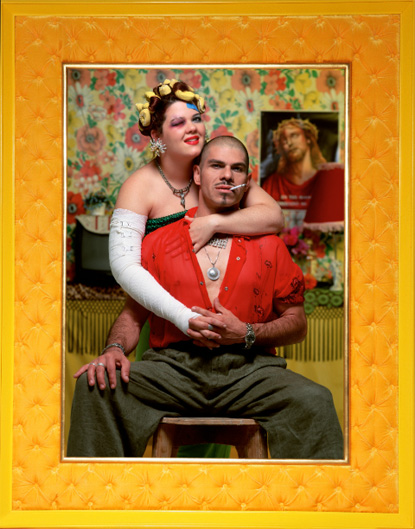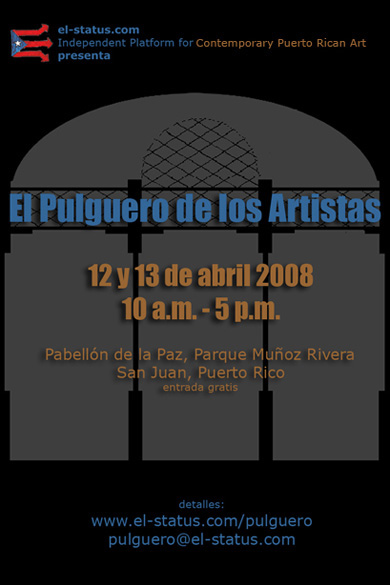|
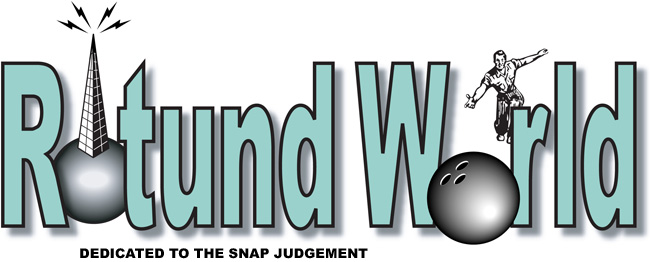
Shelter from the Storm
Did we say that nothing much is going on these days in the Puerto Rican contemporary art scene? That we’re caught like woozy barnyard fowl in that lull before the storm which our very own international art fair, CIRCA, lashes the island with every spring? If we said such things, we misspoke. In the couple of weeks leading up to CIRCA’s much-anticipated third edition—beginning Friday, April 11—there has been more than mere hyperventilating and frenzied preparation. A number of shows have opened—some have come and gone almost in a heartbeat—and the fifth issue of Teresa López’s giant compendium of island culture, Orificio, had its coming-out party at Galería 356. It was back to back and belly to belly, cultural merrymaking of the highest order. No sanjuaneros worth their bohemian pedigrees missed this party.
Galería Guatibirí, in Río Piedras, was the scene of an opening of yet another printmaking show, and we hardly say this with an air of exasperation or even slight annoyance since any veteran Rotund-traveler knows that we love prints. The youths just keep pumping these things out, these oddments that almost don’t even resemble the graphic, 2-D wallworks of yore. Although we confess that the shows are beginning to have a kind of sameness, due in part to the cast of characters, a kind of ensemble that rotates in and out of the city’s university galleries, halls of culture, and largely non-commercial spaces. The Guatibirí exhibition is titled Después del llanto, which is another distinctive feature of such shows: a name which abounds in not-nearly-literary, self-referential irony and borders on the silly. The works generally do no such thing, however, forever making our hearts sing for their earnest cleverness—if not quite audacity—and genuine love of craft. We don’t know, perhaps we’re waiting for the next generation of self-propelled, relevant postermakers or a whole slew of artists who can equal Raquel Quijano for ingenuity in carrying printmaking to a significantly higher level. That said, we really, really like the show. José Ortiz continues to push the wry, clean graphic image as a pleasure in itself with his lightbox Voluntarios panópticos, 2008; in this case giving his formal scrupulousness added oomph with something we always recommend to artists: more red.
Omar Velázquez similarly likes to transpose the diagrammatic imagery of traditional printmaking onto materials that his forebears probably would have thought mad: altars, for example, and silky pouches with tattoo motifs. His very large ink-on-paper woodcut, Moriviví, 2007, is rife with symbolism, all pretty much lost on us but kind of icky: dogs licking a man’s bare calves and sniffing about his coat while he proffers one hand to the viewer and holds a small goat in his lap with the other. Tucked in a nearby corner of the room is a lamb’s head on a cowry-shell box with ritual candles—of the artist’s own design —nearby. Ambiguous, to be sure, though definitely touched with dark, spiritualistic allusions.
Zinthia Vázquez does not always turn up in these shows, but it’s nice to see her work because of the way she uses traditional decorative patterning to create images of startling force and immediacy. A close look at her Guess who’s coming to town, 2008, reveals the double entendre of the title. The soldier playing soccer with the boy—is it farfetched to see the present Iraq war here?—has for a uniform Christmas wrap featuring the Saint Nick that Coca-Cola invented; our most Disneyesque version of the jolly old elf at work and play. A not very happy reflection on either Christmas or our presence in the Middle East.
For political potshots, however, no one outdoes Garvin Sierra, and his flashing triptych Igualito al pai, 2008, continues to dazzle if not quite satisfy. The satisfactions in this show come from Jorge Rito’s minute-long big-skull video Carro Caravel, 2007, and a trio of manipulable puppet-stage boxes by Elsa Meléndez, another set in a series that’s become her signature work. For Después del llanto, Elsa has brought to life several of the principals of this show, most notably the gallery’s owner, Rubén Malavé. At the lower right, Omar Velázquez. At the opening, someone said that Elsa is quickly becoming the chronicler of the contemporary scene of the early twenty-first century, and that’s one reason we believe in her work.
Gallery Guatibirí is located in Río Piedras and doubles as a frame shop, so you’ll likely find it open during regular business hours. If you try this number—787-250-1959—you may raise the good Sr. Malavé himself, or someone who can give you the lowdown on directions and hours to see the show. And see it you should.
Lord knows we’ve been trying to peruse the new Orificio, but it’s a big, big bite to chew, as they say in some parts. It’s a two-fer, in fact, issues #4 and #5 in one fat volume. The steadfast genius behind Orificio, Teresa López, periodically invites local vultures of culture to send in what they will, choosing her personnel provocatively and hoping for the best. The results are uneven, of course. There are a lot of projects that, if you’ve been paying the least bit of attention, you’ve seen before ad infinitum, such as Papo Colo’s Jumping the Fences. Ada Bobonis’s proposal for Estados sensibles, which had a spectacular real-life run as an installation at Museo de Arte de Puerto Rico, seems sketchy on the page. A share of the writing is dense and hyper-academicized—watch out for those column-inches of footnotes!—but Laura Bravo is gratifyingly straight-talking in her discussion of recent photographic work by one of our faves, Philip-Lorca diCorcia. For those of us who adore the vagaries and paradoxes of language, Orificio is a redolent trove of the incisively far-out, the hilariously off-putting, and the plain eccentric. Dr. Pitt von Pigg’s contributions to both issues pretty much say it all. Dr. Pigg is our barber, we swear. Proudly hateful, profane, a lovely guy when he is not a sneering, reactionary beast. Von Pigg is worth the price of purchase all by himself. There is much, much more and plenty of it looks intriguing, including a long essay by López on the artistic vanguard in Puerto Rico during the 1970s and 80s. We can’t wait. If you weren’t among the lucky ones who went to the big Orificio giveaway at Galería 356, you’ll have another opportunity to get a free copy by attending El pulguero de los artistas during CIRCA, at El Pabellon de la Paz, Parque Luis Muñoz Rivera. Details about this amazing event are below. In regard to Orificio, you can also download a .pdf of the new issue here. Much like Elsa Meléndez’s puppet boxes, Orificio is something of a snapshot of the island contemporary scene right now. This is only a sampler of what’s been going on in the surprisingly lively local panorama, which was declared “over” and “completely kaput” not so long ago by such snooty savants as Pedro Vélez in his seething online stinkpot, Box Score. Perhaps not in those exact words, but the predictions of Vélez are never less than dire and he likes to spice his delivery with considerable blubbering, head-shaking, and the cyberspace equivalent of chest-poking. If only Vélez smoked a big cigar and wore an ill-fitting wig, his image as one of what the late, great Spiro Agnew called “the nattering nabobs of negativity” would be complete. Give it a rest, Pedro.
Anyhoo, we really haven’t the stamina to go over all the hubbub with a fine-tooth comb, as they say, but suffice it to mention here that Museo de Arte de Caguas just opened a considerably expanded version of the exhibition which curator Elsa Meléndez put together for Museo de las Américas in La Ballajá, Terruño y paraíso perdido, an homage to cagueño Carlos Osorio. (We mention La Ballajá show previously in Rotund World, here.) The Caguas museum version has an expanded roster of artists and more works by many of the contributors. Some things you’ve no doubt seen before if you’ve been paying attention, but rediscovering such pieces as Ramón Feliciano’s trashy, tremendo Autobiografía and the flashy stainless steel contraption known as Mini Eclipse, 2006, by Erik Guzmán Shorrock made us giddy as squirrels in May. (If, like some boricuas, you don’t know what a squirrel is, look around next time you’re strolling through Central Park. Some of those creatures are rats, it’s true, but the cute, brown or gray ones with the bushy tails tend to be tree- dwelling Sciurus. If, like us, you enjoy annoying your friends, repeat the following several times in the course of a dinner party or a night out at the clubs: “The squirrels are coming to get you. They think you’re nuts.” Also useful to entertain four-year-old nephews and nieces, at least one time.)
As usual, it’s hard to tell from the catalogue how long, exactly, the show lasts, but you can call the museum at 787-744-8833, extensions 1828, 1836, or 1838, or email the institution here. The shows tend to stay and stay and stay. They’re almost always worth a visit. Do you think that Quintín Rivera-Toro is sometimes careless, no matter how cool his concepts? Check out his pristine, eerie photographic self-portrait Sí, licenciado, licenciado, mi licenciado, 2007, in Terruño y paraíso perdido. Nestor Otero also has a nice, relatively small work, and as star of the show, Carlos Osorio’s paintings shine. But in regard to painting, one of the surprise hits, for us, is a study of a flat tire by none other than that master of the wicked pen, Carlos Fajardo. It’s an acrylic on canvas work that’s titled Pintura estética, from 2007. Another museum show which opened to a considerably less lustrous effect is Museo de Arte Contemporáneo’s Feminismos. We’ve praised curator Brenda Torres Figueroa in the past for doing a lot with a little, but it looks like the limitations of putting together themed shows from the institution’s largely artist-donated permanent collection have finally caught up with her. Feminismos strains hard to say something about “the body, behavior, and artifice,” as the exhibition’s subtitle has it, but it’s a lifeless exercise, a thin idea badly serving the works arrayed around it. It shows, more than anything, what happens when you try to illustrate a theory with given artworks rather than allowing the idea to grow organically out of what you have. And Camille Paglia as the inspiration for most of the exhibition’s texts? Please. That’s reaching for something your public is almost guaranteed to blanch at.
Favián Vergara’s large lambda print, Me Golpeaste Tanto Anoche/You Beat Me So Hard Last Night, 2006, is an impactante way to open the show, but it turned out to be one of the few highlights. Its best feature, we believe, is its dark, dark humor, something that might have redeemed the whole enterprise if there had been more of it. A CD accompanies the work, Astrid Hadad singing Ray Romano’s You Beat Me So Hard Last Night. Image courtesy of Primer Piso Gallery. Feminismos lasts until July 20th, and you can get an idea about whether you want to visit the show by going to the museum’s website. We suggest you do take a live look, however. Museo de Arte Contemporáneo is open Tuesday to Saturday, 10 a.m. to 4 p.m., and Sunday 12 to 4. It’s located at the juncture of avenidas Ponce de Leon and Roberto H. Todd in Santurce, and if you have any questions about the museum or the present exhibition, you can phone 787-977-4030. Who says bankers have no souls? Puerto Rico’s Oriental Group, which describes itself as a “diversified company of financial services,” apparently loves art. Or young artists, at any rate. Thanks to the initiative of an active local collector—a quite modest individual whom, we’re sure, would prefer to remain anonymous—Oriental Group just awarded cash prizes to three persons in its first-ever Young Artist Competition. Christopher Rivera walked away with the top prize of $7,000, Jaime Rodríguez got $5,000, and Myritza Castillo received $4,000. That’s serious money, and if any of us were wearing hats, we’d take them off to Oriental Group. Not only are the prize-winners heavier in the pockets, their works become part of the Group’s collection. Felicidades all the way around. ’Spérate, ’spérate, ’spérate. Pedro Vélez likes to flaunt the writing of distant critics in toney publications, but apparently he missed one of the greatest slugfests in the annals of recent art history. In successive issues of Art Forum, perhaps the most respected—and reviled—publication in the world of contemporary art, some of the grandest of artworld grandees took to insulting each other in print as if exchanging chest blasts in the maloliente locker room of a Río Piedras gym. It was a spectacle, to be sure, the gods bellowing and heehawing back and forth, and well worth plodding through the many-thousand-word letters to the editor. At the center of this dustup was recent Venice Biennial curator Robert Storr, who took unbelievably lengthy, unhealthily detailed umbrage at the somewhat less than glowing notices his efforts got on the parts of Okui Enwezor, Jessica Morgan, and Francesco Bonami. The language alone was terrific and revealing. Storr called Bonami “a second- or third-rate” person and “a stalker,” and compared him to “a clown who’s lost his timing.” Launching into a strained, convoluted defense of his work in response to Enwezor’s relatively mild—and certainly brief—criticism of the Biennial, Storr labeled the writings as “a critical gang mugging.” If you can lay your hands on the December, 2007, and January and February, 2008, issues of Art Forum, treat yourself to, first, the critics’ judgements on the Venice Biennial, then as many of Storr’s 8,000 words as you can stomach, and finally the three critics’ deeply offended responses to Storr’s unseemly ranting. This brouhaha may have made headlines in all the world’s artblogs, but we’ve had our heads down for the last several months, hardly bothering to check our fave websites fimoculous, The Next Few Hours, and Critical Miami, let alone the blogs of our professional brethren. For something completely the same, go back in time to our recent consideration of public art acá y allá, right here. The madness that is CIRCA will begin soon enough. As practicing “journalists,” we anticipate the too-long, consummately prefab weekend with a certain amount of dread. But many of the events surrounding CIRCA—thought up by youths as busy-tailed as any flying squirrel, and bound, no doubt, for a rodent’s fate, flattened on the road of commerce like so much roadkill—are invariably as fun and exciting as a good rock and roll concert. We’ll leave you to visit the CIRCA website or the always-dependable ¿Dónde Veo Arte? to get a complete rundown of events. We do want to alert you to one thing, however: Lisa Ladner’s El pulguero de los artistas. This is one fleamarket we’re not going to miss.
|
